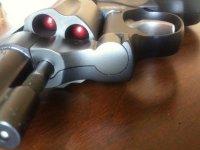Your barrel needs to be turned, if you want the air gap tightened up. .004-.010 air gap is what they set them for.
This is copied from the FAQ sticky above:
Feeler gauge inspection
Here are the general specs for basic checking on S&W revolvers.
Whenever I check the specs of S&W revolvers there are 3 things that I check, air gap, head space and endshake.
In a nut shell here is how I do it.
AIR GAP:
Proper air gap on S&W revolvers is .004-.010 inch. Rotate the cylinder and check it in more than one spot. The cylinder won't be perfectly square, it will vary some. Measure it at the forcing cone. Too little gap the gun will jam, too much and the gun will start spitting, plus lower bullet velocity and accelerated top strap erosion.
Endshake:
Set end shake for less than .002". Here is how I test it. Push the cylinder forward, check it. Pull the cylinder back, check it again. The difference is endshake. Measure it at the forcing cone.
If I need to adjust it, I use end shake bearings, instead of peening or flaring the yoke's barrel. A gun needs some endshake to run, too little and it will jam, too much creates all kinds of problems, possible light hammer strikes, poor carry up etc.
Head space:
Here's how I test it: With new or once fired cases in all chambers (no primers). Wedge the cylinder back by placing a shim between the barrel and cylinder face (a gap gauge works well. This forces the cylinder back where the extractor's hub is bottomed out on the recoil shield. You should have .008-.012" (.010" optimum) gap between the case heads and the firing pin hole on the frame.
Keep in mind the ejector and cylinder are made and fit at the factory to work together for proper head space. Swapping parts may throw off the head spacing.
Normally, head space doesn't change unless someone files down the hub of the ejector.
I added the gage specifications below for each particular caliber (from the armorer's manual):
38,357,41,44 .060"-.068"
22 magnum .004"-.008"
45 ACP .090"-.094"
45 Long Colt .060"-.068"
38,357 w/cylinder Counter Bore .012"-.018"
In addition no revolver should be adjusted to a single action trigger pull of less than 3 LBS.
YOKE ENDPLAY
To adjust the yoke screw:
Use a file and lightly file the bottom of the screw until the cylinder swings without a lot of resistance. I like them with a bit of drag, but not binding.
If you tried the screws, then the yoke stud is too long (or the slot is worn) and needs to be adjusted.
You need to flatten the button of the yoke. Find a 1 inch round bar (Babbitt bar would be nice) and place the yoke body on it. Using a hammer lightly tap the button (on the corner) to make it flatter, (peen only 1/2 way around) then if you need to, file out the slot where the screw fits so it can be tightened up. Only file what you have to, or it will be loose again. You're trying to narrow the slot opening where the screw goes (Look for the screw rub mark). Your not trying to move the whole 9 yards, just deform the slot.
Tap lightly, check the fit often.




